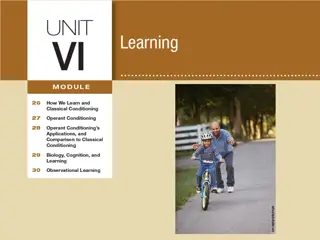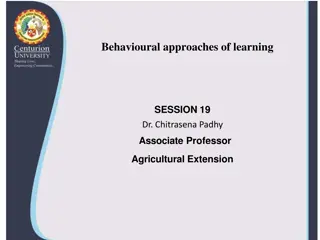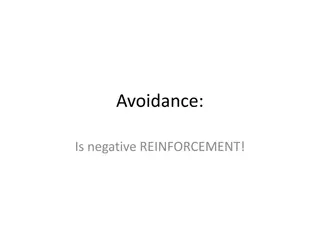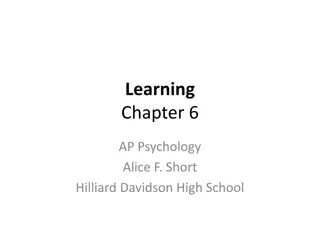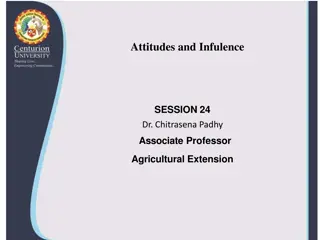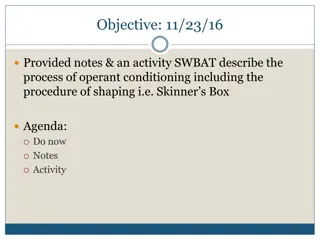
Operant Conditioning Theory and Its Applications
Explore the concept of operant conditioning, a method of learning that utilizes rewards and punishment to modify behavior. Discover how behavior is shaped through positive and negative reinforcement, as well as the key principles outlined by behaviorist B.F. Skinner. Dive into the theory's implications on human behavior and its impact on shaping responses in different environments.
Download Presentation

Please find below an Image/Link to download the presentation.
The content on the website is provided AS IS for your information and personal use only. It may not be sold, licensed, or shared on other websites without obtaining consent from the author. If you encounter any issues during the download, it is possible that the publisher has removed the file from their server.
You are allowed to download the files provided on this website for personal or commercial use, subject to the condition that they are used lawfully. All files are the property of their respective owners.
The content on the website is provided AS IS for your information and personal use only. It may not be sold, licensed, or shared on other websites without obtaining consent from the author.
E N D
Presentation Transcript
StudyMafia.Org Operant Conditioning Submitted To: Submitted By: Studymafia.org Studymafia.org
Table Contents Definition Introduction Operant Behavior The Operant Conditioning Theory Types of Responses in OC Positive Reinforcement Negative Reinforcement Conclusion 2
Definition Operant conditioning, sometimes referred to as instrumental conditioning, is a method of learning that uses rewards and punishment to modify behavior. 3
Introduction Through operant conditioning, behavior that is rewarded is likely to be repeated, and behavior that is punished will rarely occur. For example, when you are rewarded at work with a performance bonus for exceptional work, you will be inclined to continue performing at a higher level in hopes of receiving another bonus in the future. 4
Operant Behavior In operant behavior, stimuli can be appetitive or aversive. Appetitive stimuli are the ones that you voluntarily approach while aversive stimuli are those you try to avoid or escape. Responses to such stimuli can either be positive or negative reinforcement. 6
Operant Behavior In this case positive and negative do not mean good or bad. Instead, positive reinforcement means introducing stimulus to increase the probability of recurrence of behavior, while negative reinforcement involves removing stimulus to encourage good behavior. 7
The Operant Conditioning Theory Operant conditioning was first described by behaviorist B.F. Skinner. His theory was based on two assumptions. First, the cause of human behavior is something in a person s environment. Second, the consequences of a behavior determine the possibility of it being repeated. 8
The Operant Conditioning Theory Behavior that is followed by a pleasant consequence is likely to be repeated and behavior followed by an unpleasant consequence is less likely to be repeated. Although Skinner was the pioneer of the operant conditioning theory, his ideas were based on Thorndike s law of effect. Skinner also believed that we do have a mind. 9
The Operant Conditioning Theory Therefore it was more productive to study observable behavior rather than internal mental events. Skinner was also an exemplary inventor. Among his gadgets was the Skinner Box, which uses subjects like rats and pigeons to record animal behavior in a compressed time frame. 10
Types of Responses in OC Neutral responses. They are responses from the environment that produce no stimulus other than focusing attention. They neither increase nor decrease the probability of a behavior being repeated. 11
Types of Responses in OC Reinforcers. They are responses from the environment that increase the likelihood of a behavior being repeated. They can either be positive or negative. Punishers. These are negative operants that make the likelihood of a behavior decrease. Punishment weakens behavior. 12
Positive Reinforcement Positive reinforcement involves the presentation of an appetitive stimulus to increase the likelihood of a behavior occurring in the future. For example, if your child does chores without being asked you can reward them by taking them to a park or handing them a treat. 13
Negative Reinforcement In negative reinforcement, something unpleasant is terminated in response to a stimulus. Over time, the behavior increases with the expectation that the aversive stimulant will be taken away. If, for example, a child refuses to eat vegetables at dinner time and a parent responds by taking the vegetables away, the removal of the vegetables is negative reinforcement. 14
Conclusion The goal of operant conditioning is simple: Reinforce desirable behaviors through a system of rewards and eliminate undesirable behaviors through targeted punishments. 15
References Google.com Wikipedia.org Studymafia.org Slidespanda.com
Thanks To StudyMafia.org





